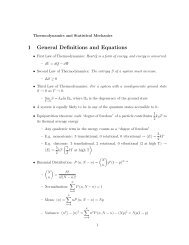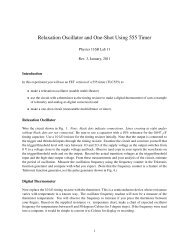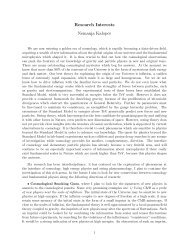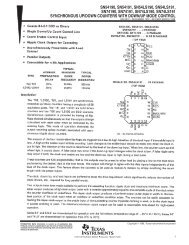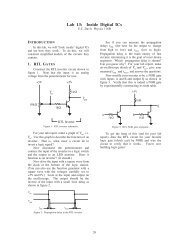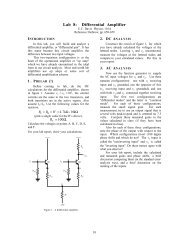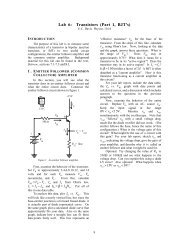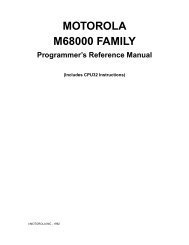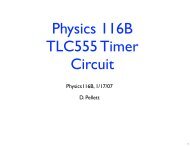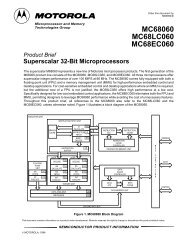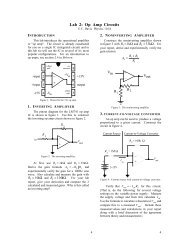M68000 Microprocessor User's Manual
M68000 Microprocessor User's Manual
M68000 Microprocessor User's Manual
You also want an ePaper? Increase the reach of your titles
YUMPU automatically turns print PDFs into web optimized ePapers that Google loves.
A bus cycle consists of eight states. The various signals are asserted during specific<br />
states of a read cycle, as follows:<br />
STATE 0<br />
STATE 1<br />
STATE 2<br />
STATE 3<br />
STATE 4<br />
STATE 5<br />
STATE 6<br />
STATE 7<br />
The read cycle starts in state 0 (S0). The processor places valid function<br />
codes on FC0–FC2 and drives R/W high to identify a read cycle.<br />
Entering state 1 (S1), the processor drives a valid address on the address<br />
bus.<br />
On the rising edge of state 2 (S2), the processor asserts AS and UDS, LDS,<br />
or DS.<br />
During state 3 (S3), no bus signals are altered.<br />
During state 4 (S4), the processor waits for a cycle termination signal<br />
(DTACK or BERR) or VPA, an M6800 peripheral signal. When VPA is<br />
asserted during S4, the cycle becomes a peripheral cycle (refer to<br />
Appendix B M6800 Peripheral Interface). If neither termination signal is<br />
asserted before the falling edge at the end of S4, the processor inserts wait<br />
states (full clock cycles) until either DTACK or BERR is asserted.<br />
During state 5 (S5), no bus signals are altered.<br />
During state 6 (S6), data from the device is driven onto the data bus.<br />
On the falling edge of the clock entering state 7 (S7), the processor latches<br />
data from the addressed device and negates AS, UDS, and LDS. At<br />
the rising edge of S7, the processor places the address bus in the highimpedance<br />
state. The device negates DTACK or BERR at this time.<br />
5.1.2 Write Cycle<br />
NOTE<br />
During an active bus cycle, VPA and BERR are sampled on<br />
every falling edge of the clock beginning with S4, and data is<br />
latched on the falling edge of S6 during a read cycle. The bus<br />
cycle terminates in S7, except when BERR is asserted in the<br />
absence of DTACK. In that case, the bus cycle terminates one<br />
clock cycle later in S9.<br />
During a write cycle, the processor sends bytes of data to the memory or peripheral<br />
device. If the instruction specifies a word operation, the processor issues both UDS and<br />
LDS and writes both bytes. When the instruction specifies a byte operation, the processor<br />
uses the internal A0 bit to determine which byte to write and issues the appropriate data<br />
strobe. When the A0 bit equals zero, UDS is asserted; when the A0 bit equals one, LDS is<br />
asserted.<br />
5- 4 <strong>M68000</strong> 8-/16-/32-BIT MICROPROCESSORS USER'S MANUAL MOTOROLA



